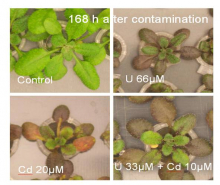The STAR project finished on 31st July 2015 - page no longer being updated
Overview of existing approaches, methods and tools developed in ecotoxicology for assessing exposures, effects and risks in a mixed contaminant context |
|---|
 Photo (N. Horemans, SCK•CEN): The impact of exposure of Arabidopsis thaliana seedlings exposed to U, Cd or U and Cd |
This The modelling of contaminant bioavailability is most advanced for metals, where the Biotic Ligand Model (BLM) provides an established framework for understanding and predicting how the medium chemistry affects bioavailability. Examples of BLM models are presented in the deliverable. The structure of the BLM lends itself well to evaluate the influence of co-contaminants on the uptake and toxicity of the metal of interest, including radionuclides. Currently it has only been applied in a few cases as a tool to understand (non-radionuclide) metal mixture effects. Nevertheless, extension of the approach to understanding the effects of mixtures of radionuclides and metals is considered feasible. Approaches and tools to assess or predict the effect of contaminant mixtures have also been reviewed. Their advantages and disadvantages and applicability in the context of assessing effects in relevant mixed contaminant scenarios that include radionuclides have been evaluated. In particular component-based approaches are described: principles of Concentration Addition (CA) and Independent Action (IA) are presented for their application to descriptive data (dose-response curves) and to dynamic and integrated DEBtox (Dynamic Energy Budget Model) approaches to assess effects of mixtures. Further, a number of whole mixture approaches is described. A comparative overview of the different methods, data requirements and applicability of these different approaches and their capacity to identify and predict mixture effects is provided. All the concepts considered have advantages and limitations for effects assessment of situations where radionuclides are present in the mixture. Finally, an overview of the state of the art on Ecological Risk Assessment (ERA) of mixtures, including radionuclides, has been provided. ERA principles for chemicals and radionuclides are summarized. No comprehensive guidelines for the ecotoxicological assessment of chemical mixtures have yet been developed. Currently, regulation for mixtures is poorly developed and mainly concerns humans. There seems to be consensus that ERA approaches based on component-based approaches (CA and IA) assuming no interactions between substances are valuable as a first tier approach to mixtures risk assessment. For the generalization of this framework, there is still a clear need for a comprehensive classification scheme for contaminants (including exposure to ionising radiation or radionuclides) to support application of CA/IA models. The report from the study is now available. Information added April 2012 |
